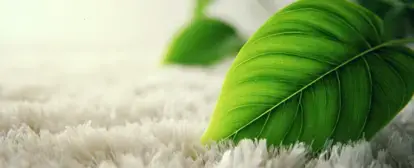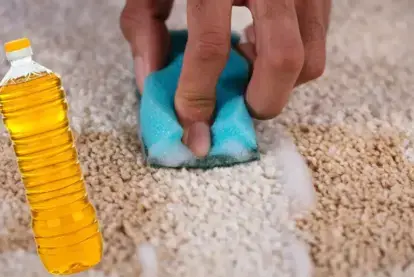
How to Clean Your Carpet the Eco-Friendly Way
Contact COIT for a professional cleaning!
Whether you're dealing with high-traffic areas, pet messes, or just everyday dirt, keeping your carpet clean is key to a healthier home.
But if you're trying to reduce your exposure to harsh chemicals and lower your environmental impact, you're probably asking: What are the most eco-friendly carpet cleaning methods?
At COIT, we’ve been cleaning carpets for over 70 years — and we know firsthand that going green doesn’t mean sacrificing results.
In this guide, we’ll break down the differences between chemical and green carpet cleaning, explore the most effective eco-friendly methods, and share how we approach eco-conscious cleaning in your home.
What Is Chemical Carpet Cleaning?
Chemical carpet cleaning relies on synthetic cleaning agents to dissolve stains, remove dirt, and sanitize surfaces.
These products often include ingredients like surfactants, solvents, detergents, pH adjusters, and even bleach.
While they’re often highly effective, they also come with trade-offs — especially when it comes to health and sustainability.
They can be highly effective at removing stubborn stains or heavy soil, but they often have a strong, lingering smell and can pose potential health and environmental risks due to their chemical composition.
Pros of Traditional Chemical Cleaning
- Fast results: Chemical cleaners work quickly on stubborn stains.
- Accessible: Many formulas are ready to use right out of the bottle.
- Cost-effective: Conventional cleaners are usually cheaper than eco-certified alternatives.
Cons of Traditional Chemical Cleaning
- Strong odors: Harsh chemical scents can linger long after cleaning.
- Health concerns: Exposure to ingredients like VOCs (volatile organic compounds) can trigger allergies, asthma, or other respiratory issues.
- Environmental impact: These solutions often contain non-biodegradable compounds that can pollute waterways and indoor air.
- Not always versatile: Many are formulated for specific stain types and surfaces, limiting their use.
What Is a Green Carpet Cleaning Solution?
Green carpet cleaning solutions are made from natural or biodegradable ingredients like vinegar, baking soda, citrus oils, plant-based surfactants, or hydrogen peroxide. They’re designed to clean effectively while being safer for your family, your pets, and the planet.
Essential oils are often added for a pleasant aroma and additional antibacterial and antifungal benefits. The idea behind green cleaning solutions is to minimize environmental impact and reduce exposure to potentially harmful chemicals commonly found in traditional cleaning products.
At COIT, we often get asked whether these green methods actually work — and the answer is yes, especially when paired with the right equipment and technique.
Pros of Eco-Friendly Carpet Cleaning
- Non-toxic: Better for kids, pets, and people with sensitivities.
- No chemical residue: Green products don’t leave behind harsh residues or trigger strong smells.
- Versatile: Many eco cleaners are safe on carpet, tile, wood, and more.
- DIY-friendly: You can make basic green cleaners with common pantry ingredients.
Cons of Eco-Friendly Carpet Cleaning
- May take longer: Some stains need more time or repeat treatments.
- Possible allergens: Essential oils and natural extracts can still cause reactions in sensitive individuals.
- More precision needed: Homemade recipes require accurate mixing and testing to avoid unwanted effects like discoloration or browning.
What Are the Most Eco-Friendly Carpet Cleaning Methods?
Not all green carpet cleaning methods are created equal. Here are the top professional and DIY options we recommend, along with how they work and when to use them.
1. Encapsulation Cleaning
Encapsulation is a low-moisture method where a cleaning solution is applied to the carpet, encapsulating dirt particles in a polymer crystal as it dries. Once dry, the crystals are vacuumed away.
- Eco Benefits: Uses very little water, dries quickly, and leaves no sticky residue.
- Best For: Regular maintenance in homes or offices with low to medium traffic.
2. Dry Compound Cleaning
Also known as dry carpet cleaning, this method uses a biodegradable cleaning compound (often plant-based) that’s spread over the carpet and worked in with a machine. The compound absorbs soil and is then vacuumed away.
- Eco Benefits: No water required; biodegradable; safe for delicate or moisture-sensitive carpets.
- Best For: Spot treatments, quick refreshes, and areas that can’t tolerate wet cleaning.
3. Steam Cleaning with Green Detergents (Hot Water Extraction)
Steam cleaning, or hot water extraction, is the gold standard for deep cleaning. When done with eco-certified detergents, it offers a powerful, green solution.
- Eco Benefits: Removes allergens, mold spores, and bacteria without harsh chemicals.
- Best For: Households with pets, kids, or allergy sufferers; heavily soiled carpets.
4. DIY Natural Cleaners
Mixing your own solution from vinegar, baking soda, essential oils, or castile soap can be a great green option — especially for small spots or odors.
- Eco Benefits: Low cost, low waste, safe for most homes.
- Best For: Deodorizing, freshening up, or tackling minor spills.
Common Green Ingredients and What They Do
If you're curious about what goes into a green carpet cleaning solution, you'd be surprised to find that most of the ingredients are familiar and can even be found in your own pantry.
We’re big fans of knowing what’s in your cleaning products. Here are a few safe, natural ingredients that can be found in both DIY and professional green carpet cleaning solutions:
- White vinegar: Cuts through dirt and neutralizes odors.
- Baking soda: Absorbs moisture and smells; safe to sprinkle on carpet.
- Citrus oils (like lemon or orange): Offer grease-cutting power and natural fragrance.
- Tea tree or lavender oil: Provide antimicrobial and antifungal benefits.
- Hydrogen peroxide: A safer alternative to bleach for lifting organic stains (like wine or coffee).
Want to try making your own? Check out our guide on Homemade Carpet Deodorizers Using Essential Oils.
How to Tell If a Carpet Cleaner Is Really Eco-Friendly
Greenwashing is everywhere — so how do you know if a product or service is actually eco-friendly?
Look for These Certifications:
- EPA Safer Choice
- Green Seal
- CRI Green Label Plus
- Ecologo
These labels ensure that products meet rigorous safety, performance, and environmental standards.
Ask the Right Questions:
- What ingredients are in your products?
- Are your solutions biodegradable or plant-based?
- How much water and energy does your method use?
- Are your tools reusable or recyclable?
At COIT, we’re happy to answer these questions because we believe transparency is part of what makes cleaning truly clean.
Green Cleaning vs DIY: When to Call the Pros
We love a good homemade solution. But sometimes, your carpet needs more than baking soda and elbow grease.
Here’s how to decide:
DIY Green Cleaning | Professional Green Cleaning |
Light stains or odor control | Deep cleaning and full carpet refresh |
Routine upkeep | Pet stains, allergens, or heavy soil |
Budget-friendly | Specialized equipment and certified products |
Time-consuming | Quick, thorough, and long-lasting results |
If you're not getting the results you want, or you're worried about damaging your carpet, that’s when it’s time to call in professionals like us.
Why Eco-Friendly Carpet Cleaning Matters
Healthier for You and Your Family
- No toxic fumes or residues
- Reduced asthma and allergy triggers
- Safer for babies and pets who spend time close to the floor
Better for the Planet
- Less water waste and runoff
- Fewer harsh chemicals entering the air and waterways
- Reduced packaging waste when products are concentrated or refillable
Improved Indoor Air Quality
Your carpet acts like a giant filter. Regular eco-friendly cleaning helps remove:
- Dust mites
- Mold spores
- VOCs
- Pet dander
Frequently Asked Questions
What is the most eco-friendly way to clean carpets?
Using a low-moisture encapsulation method with plant-based, certified green products is one of the most sustainable options. For DIY, baking soda and vinegar can handle small messes without harming your health or the environment.
Are professional carpet cleaners eco-friendly?
It depends on the provider. At COIT, we offer eco-friendly cleaning options that use certified solutions and efficient tools that reduce water and energy use.
Do green carpet cleaning methods really work?
Yes, especially when they’re matched to the right stain or surface. While they might require more time on tough stains, green methods are just as effective for most everyday cleaning needs.
What ingredients should I avoid in carpet cleaners?
Watch out for:
- Ammonia
- Bleach
- Phthalates
- Artificial dyes
- Sodium hydroxide
These ingredients can trigger health problems or harm indoor air quality.
Coit’s Eco-Friendly Carpet Cleaning Services
COIT understands the usage of these solutions. When we come to your home, we deliver a cleaning service that is catered to your needs. If you do not want harmful chemicals to be used when cleaning your home, then we will find a way to accommodate your needs using a different cleaning method.
At COIT, we are dedicated to delivering the best solution for your carpet and your home.



